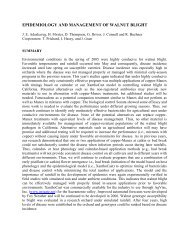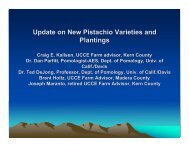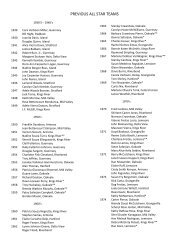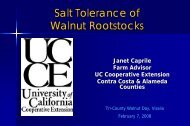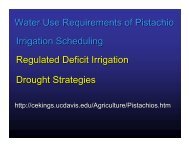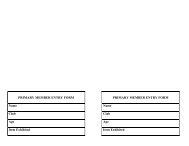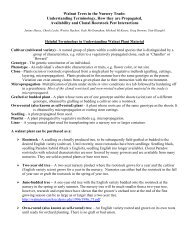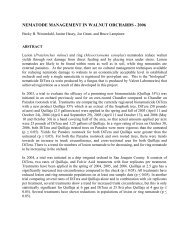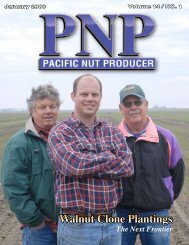using aerosol pheromone âpuffersâ - Walnut Research Reports
using aerosol pheromone âpuffersâ - Walnut Research Reports
using aerosol pheromone âpuffersâ - Walnut Research Reports
You also want an ePaper? Increase the reach of your titles
YUMPU automatically turns print PDFs into web optimized ePapers that Google loves.
2005 in most blocks. The large trap captures in the Northeast Vinas were attributed to puffers<br />
being deployed after the start of the first codling moth flight. At the SJ site there were no<br />
consistent differences between 2005 and 2006 in seasonal trap catches (Figure 8).<br />
Laminate Micro-Flakes<br />
In these trials, the traps baited with the combo lure and placed high in the canopy showed CM<br />
flight activity in all treatments. The 1X traps, hung low in the tree, show that the treatment is<br />
working when they catch zero moths in the <strong>pheromone</strong>-treated area, but still catch moths in the<br />
Grower Standard and Untreated Control. This trap shutdown is measured by comparing total 1X<br />
trap catches in the Hercon block to total trap catches in the Untreated Control, both 1X-Low and<br />
combo-High (Figure 9). The 1X trap at the Tehama site was shutdown 100%, the Butte and<br />
Glenn sites caught a couple of moths in the 1X traps, resulting in slightly less than 100%<br />
shutdown. These moths were found in the 1X traps in mid- and late-August when populations<br />
were increasing and long periods of very high temperatures may have started to reduce the<br />
effectiveness of the <strong>pheromone</strong> in the Hercon flakes.<br />
In-season damage assessments in the canopy were conducted three times at the Butte and<br />
Glenn sites, but only once at the Tehama site because a pruning tower was required to reach the<br />
tree canopy. Later season canopy counts can be a good indicator of harvest damage levels.<br />
Table 6 shows data from the canopy count in early August, at the end of the second flight, with<br />
CM damage well below 2%.<br />
To catch any Hercon flakes that fell from the trees, the plastic sheets were placed on the ground<br />
before the first application. The sheets were put between trees of varying canopy size and<br />
density to represent the whole orchard. The highest numbers of flakes were found on the plastic<br />
sheets just after the application, and for about 2-3 weeks afterwards (Figures 10 & 11). The<br />
Tehama county site was the Tehama variety which is a later leafing variety with a larger tree<br />
canopy and had less leafing than the other 2 orchards at the 1 st application allowing a high<br />
number of the flakes to fall on the plastic. At the 2 nd application it had the least flakes fall when<br />
it was fully leafed out. For the remaining weeks, very few flakes dropped on the plastic<br />
indicating that, with good contact between the leaf and the flake, the majority of the flakes<br />
remained in the canopy. Some flakes were found still stuck on leaves at the end of the season as<br />
the trees began to defoliate.<br />
Harvest samples reported here contained data from only the “sound” nuts, as described in the<br />
above section. Damage from both codling moth and navel orangeworm was recorded for each of<br />
the treatment blocks (Table 7). Harvest data from the three trials was pooled, with each location<br />
as a rep. Average codling moth damage was less than 1% in all treatment blocks (Figure 12),<br />
with no statistically significant differences between them. In general, the Hercon-treated blocks<br />
were supplemented with one Lorsban spray, and one site received another Lorsban application<br />
for walnut husk fly. The Grower Standard blocks all received either two or three insecticide<br />
applications. Numerically, the harvest damage in the Hercon-treated blocks was half that of the<br />
Grower Standard blocks, showing that Hercon micro-flakes provided codling moth damage<br />
suppression better than conventional insecticides. This shows <strong>pheromone</strong> mating disruption can<br />
be integrated into a codling moth management program and can control CM damage as well as<br />
conventional methods.



